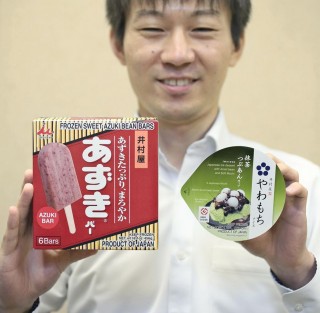Loading
Search
▼ Japan’s Ice Cream Exports Keep Trending To Record Highs
- Category:Other
Japan may be known for exporting cars and electronics, but people around the world seem to scream for Japanese ice cream as well.
Through the first six months of this year, the total export value of ice cream and other frozen desserts reached ¥3.21 billion, more than 40% higher than the same period last year.
The rapidly increasing popularity of Japanese food overseas has been said to be a reason for the boom in Japanese ice cream, along with lower tariffs.
Lotte Co. began full-scale exports of its big-selling Yukimi Daifuku around 2015. The product is now sold in about 20 countries and regions including Canada, Thailand and Vietnam under the name of Yukimi.
The products are packaged at a factory in Japan and shipped overseas in refrigerated containers kept at minus 25 C.
The company said Yukimi is popular for the “Japanese touch” associated with the product and the soft texture of the mochi, which does not become hard even when frozen.
Imuraya Group Co. exports its mainstay products such as Azuki Bar and Yawamochi Ice Cream to the United States and Taiwan.
Akagi Nyugyo exports its GariGarikun ice pops to Taiwan.
From 2000 to 2012, the annual export value of ice cream had stayed in the ¥400 million to ¥800 million range, according to the Finance Ministry.
The ice cream boom took off after washoku traditional Japanese cuisine was added to UNESCO’s Intangible Cultural Heritage List in 2013.
More people are eating at home during the pandemic, leading to a windfall in sales of products for home consumption.
Foreign press covering the Tokyo Olympics might also be giving a boost to overseas sales this year. One reporter’s post on Twitter about how wonderful Yukimi is attracted much attention abroad.
While shipping costs and tariffs make the prices of ice cream and frozen desserts roughly double what they cost in Japan, trade agreements to lower tariffs are expected to further encourage exports.
While shipping costs and tariffs make the prices of ice cream and frozen desserts roughly double what they cost in Japan, trade agreements to lower tariffs are expected to further encourage exports.
In September, Imuraya Group is expected to start locally producing Azuki Bars in Malaysia. Imuraya plans to sell each bar at a price planned to be 4.6 ringgit (about ¥120). The firm is also considering selling the product in neighboring countries, aiming to increase its overseas sales ratio to 7.5% in fiscal 2023 from 5.4% in fiscal 2020.
Imuraya Chairman Takeo Asada expressed his desire to make Malaysia the gateway to Southeast Asia. As the economies of Southeast Asian countries have developed, their infrastructure has been put in place to distribute frozen ice cream and to sell the products in frozen cases at retail stores.
“As the population declines in Japan,” an official of the Japan Ice Cream Association said, “such companies place high expectations on ice cream demand in Southeast Asian countries, where the weather is warm all year round.”
Through the first six months of this year, the total export value of ice cream and other frozen desserts reached ¥3.21 billion, more than 40% higher than the same period last year.
The rapidly increasing popularity of Japanese food overseas has been said to be a reason for the boom in Japanese ice cream, along with lower tariffs.
Lotte Co. began full-scale exports of its big-selling Yukimi Daifuku around 2015. The product is now sold in about 20 countries and regions including Canada, Thailand and Vietnam under the name of Yukimi.
The products are packaged at a factory in Japan and shipped overseas in refrigerated containers kept at minus 25 C.
The company said Yukimi is popular for the “Japanese touch” associated with the product and the soft texture of the mochi, which does not become hard even when frozen.
Imuraya Group Co. exports its mainstay products such as Azuki Bar and Yawamochi Ice Cream to the United States and Taiwan.
Akagi Nyugyo exports its GariGarikun ice pops to Taiwan.
From 2000 to 2012, the annual export value of ice cream had stayed in the ¥400 million to ¥800 million range, according to the Finance Ministry.
The ice cream boom took off after washoku traditional Japanese cuisine was added to UNESCO’s Intangible Cultural Heritage List in 2013.
More people are eating at home during the pandemic, leading to a windfall in sales of products for home consumption.
Foreign press covering the Tokyo Olympics might also be giving a boost to overseas sales this year. One reporter’s post on Twitter about how wonderful Yukimi is attracted much attention abroad.
While shipping costs and tariffs make the prices of ice cream and frozen desserts roughly double what they cost in Japan, trade agreements to lower tariffs are expected to further encourage exports.
While shipping costs and tariffs make the prices of ice cream and frozen desserts roughly double what they cost in Japan, trade agreements to lower tariffs are expected to further encourage exports.
In September, Imuraya Group is expected to start locally producing Azuki Bars in Malaysia. Imuraya plans to sell each bar at a price planned to be 4.6 ringgit (about ¥120). The firm is also considering selling the product in neighboring countries, aiming to increase its overseas sales ratio to 7.5% in fiscal 2023 from 5.4% in fiscal 2020.
Imuraya Chairman Takeo Asada expressed his desire to make Malaysia the gateway to Southeast Asia. As the economies of Southeast Asian countries have developed, their infrastructure has been put in place to distribute frozen ice cream and to sell the products in frozen cases at retail stores.
“As the population declines in Japan,” an official of the Japan Ice Cream Association said, “such companies place high expectations on ice cream demand in Southeast Asian countries, where the weather is warm all year round.”
- August 15, 2021
- Comment (0)
- Trackback(0)


